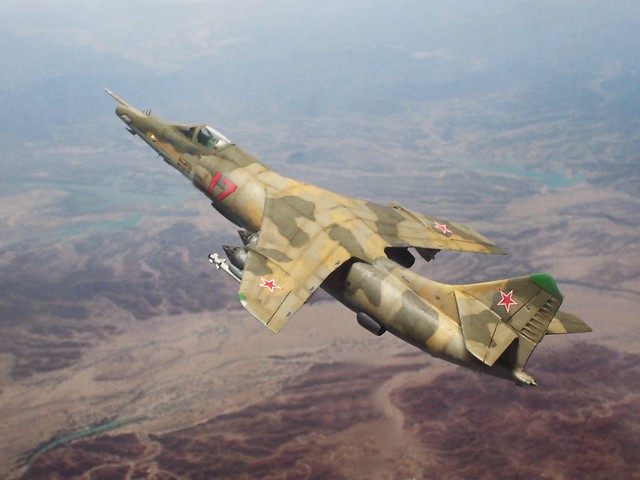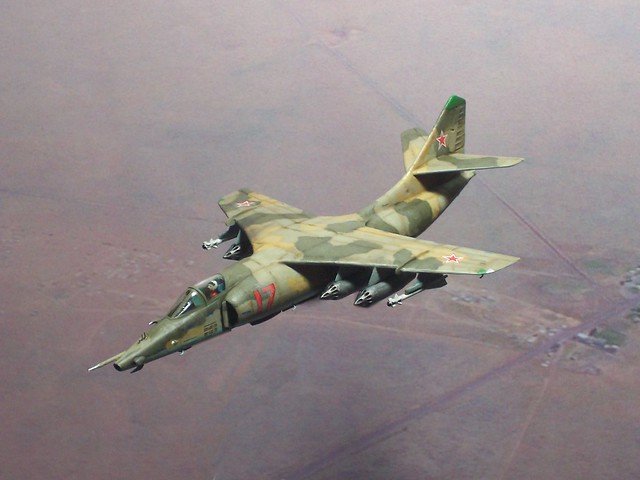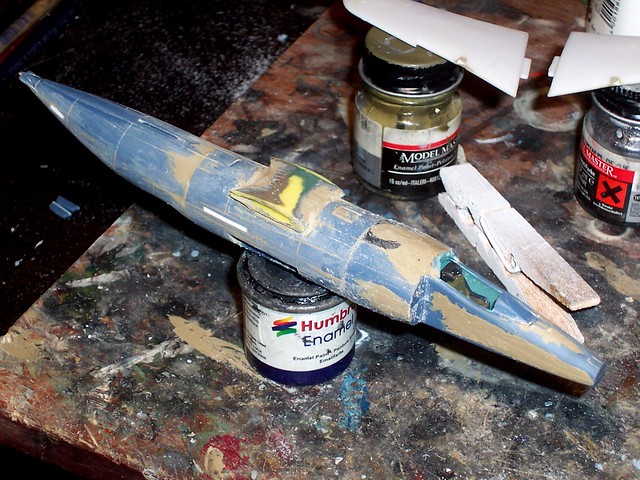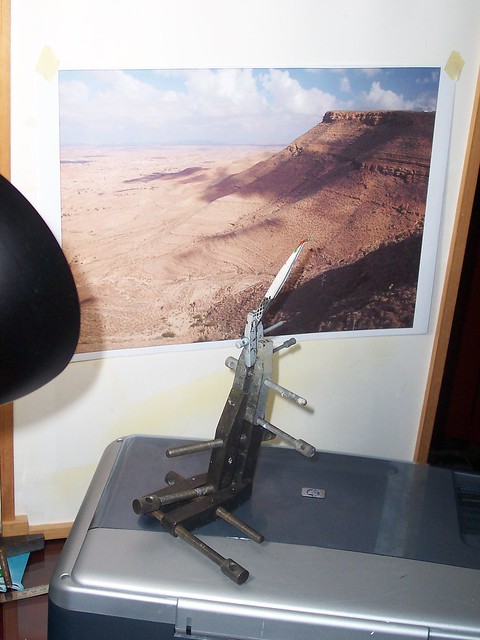Neues Jahr und ein Publikum, ich hau’ noch einen vom Ende 2013 raus…

 Some background:In early 1968, the Soviet Ministry of Defense decided to develop a specialized shturmovik armored assault aircraft in order to provide close air support for the Soviet Ground Forces. The idea of creating a ground-support aircraft came about after analyzing the experience of shturmovaya (ground attack) aviation during World War II, and in local wars during the 1950s and 1960s. The Soviet fighter-bombers in service or under development at this time (Su-7, Su-17, MiG-21 and MiG-23) did not meet the requirements for close air support of the army. They lacked essential armor plating to protect the pilot and vital equipment from ground fire and missile hits, and their high flight speeds made it difficult for the pilot to maintain visual contact with a target. Ordnance load and loiter time were also insufficient.
Some background:In early 1968, the Soviet Ministry of Defense decided to develop a specialized shturmovik armored assault aircraft in order to provide close air support for the Soviet Ground Forces. The idea of creating a ground-support aircraft came about after analyzing the experience of shturmovaya (ground attack) aviation during World War II, and in local wars during the 1950s and 1960s. The Soviet fighter-bombers in service or under development at this time (Su-7, Su-17, MiG-21 and MiG-23) did not meet the requirements for close air support of the army. They lacked essential armor plating to protect the pilot and vital equipment from ground fire and missile hits, and their high flight speeds made it difficult for the pilot to maintain visual contact with a target. Ordnance load and loiter time were also insufficient.


In March 1969, a competition was announced by the Soviet Air Force that called for designs for a new battlefield close-support aircraft. Participants in the competition were the Design Bureaus of Sukhoi, Yakovlev, Ilyushin and Mikoyan. The original request was for a simple, relavtively light aircraft, that was easy to produce and maintain and would allow a high survivabilty in a combat environment.
The aircraft was to be powered by two Ivchenko AI-25T non-afterburning turbofans, each with a thrust of 1.750 kgp (3.860 lbst) - a modification of the AI-25 developed for the Yak-40 feederliner, and the same engine that powered the Czech-built L-39 Albatros trainer. The aircraft was to carry an internal cannon and was only intended to carry unguided weapons - bombs of up to 500 kg caliber and rockets/rocket pods.Sighting was to be simple, consisting of a collimating gunsight and a laser rangefinder.
Normal combat payload was to be 1.500 kg (3.310 lb), increasing to 2.500 kg (5.511 lb) in overload configuration. Normal TOW would be 8.200 kg (18.080 lb) and MTOW in the 10.000 kg (22.050 lb) range.


All OKBs made submissions, but in the course of the proposals the requirements were widened, eventually necessitating a bigger, more capable aircraft. This eventually led to the Ilyushin’s Il-42 (later renamed into Il-102) and Sukhoi’s T-8 (the later Su-25), which remained in the official competition and the Su-25 would, aftre a long development phase, turn out to be the winner.
OKB Yakovlev had been late with its submission, which was still based on the original requirement. it was clear that their aircraft, internally known as the Yak-35, would neither meet the more demanding profile, nor offer the development potential for a heavier type. Anyway, OKB Yakovlev kept the development going, as a lot of export potential was expected.

Until May 1970 a total of three prototypes were built and successfully tested. The Yak-35 was a compact aircraft with clean lines, and it took the experience from the recently built (but rejected) Yak-30/32 trainer (NATO code "Magnum/Mantis") further. The modern design featured shoulder-mounted, slightly swept wings and a swept cruciform tail. The AI-25T engines were buried side by side in the rear fuselage, fed by lateral air intakes. The pilot sat in an armored cockpit that would withstand 0.5" caliber fire, and the slanted nose offered good for- and downward view. The aircraft reminded vaguely of the Saab 105 trainer or Sukhoi's initial, light T-8 design.

The rugged landing gear with single low pressure tires retracted into the fuselage. Armement compriseda pair of 30mm Nudelman-Richter NR-30 cannons with 100RPG, mounted under the air intakes, and a total of seven hardpoints (three under each wing, one under the fuselage) for ordnance. The inner pair of pylons was "wet" and could carry PTB-600 drop tanks, the fuselage hardpoint was intended for extre equipment like a reconnaissance pod, an ECM jammer or (in later versions, see below) guidance pods for air to ground missiles. For self-defence, IR-guided missiles like the R-3S, R-13M and later the R-60 could be carried on the outer pylons.


Avionics included a passive SPO-10 Sirena 3M RHAWS, coupled with a set of KDS-23 chaff/flare dispensers at the rear base of the fin, and an active SPS-141 Siren jammer. A Fon laser rangefinder was fitted into the nose tip, coupled with an S-17VG-1sighting mechanism, a DISS-7 doppler speed and drift measurement unit and a PKB-3 sight for toss bombing, an ASP-17B gunsight, an RV-5R radar altimeter and a V-144 computer.
Western officials first became aware of the new type during the October Parade 1972 in Moscow, when the three initial Yak-35 made a single pass at medium altitude. The unknown type immediately received the NATO code "Fraudster". The prototypes and two static airframes continued the development program at slow pace - no serious problem occured, and the Yak-35 turned out to be a stable and agile weapon platform, receiving positive praise from the test pilots.


As time went by, things turned into favor of the the Yak-35, which eventually got its chance: As the shturmovaya program around the Su-25 ran into more and more delay, and a new attack aircraft was direly needed - not long ago, tensions with China concerning the disputed Damanskiy and Kirkinskiy Islands on the Ussuri River had caused much alert. Finally, the Yak-35 was ordered into production, while parts of its fuselage design had already been used for the Yak-38 VTOL aircraft for the Soviet Navy.
From 1974 on the Yak-35 was delivered to front line squadrons, in parallel with the VG Su-17 fighter bomber. The service aircraft were updated with Delta-N radio guidance equipment, placed in a fairing in front of the fin, which would allow the Yak-35D ('dorabotanyy' = Updated; NATO code "Fraudster B") to carry radio-guided AGMs like the Kh23 or Kh-25 missiles. The emitter had to be carried in an external pod, though, normally placed under the fuselage. A pair of these missiles could be carried on launch rails on the inner pair of pylons.


A total of 110 Yak-35Ds were built until 1979, all of them remained in Soviet Air Force Service, and almost exclusively in transbaikalian units. None of them were deployed to Afghanistan, as the rather weak engine powered was deemed unsatisfactory for the 'hot and high' conflict theatre.
From 1982 on the Yak-35Ds were quickly replaced by the then-finally-ready Su-25 and relegated into second line services. Most of the remaining Yak-35Ds were kept in use for weapon training, mostly at flight academies along MiG-21 fighters until 1990, and some served as target tugs with frontline units in the Far East. No specimen was ever exported.
General characteristicsCrew: One
Length incl. pitot: 14.54 m (47 ft 7 3/4 in) incl. pitot
Wingspan: 9,52 m (31 ft 2½ in)
Height: 4.6 m (15 ft ½ in)
Empty weight: 6.525 kg (14.375 lb)
Loaded weight: 8.750 kg (19.275 lb)
Max. take-off weight: 11.400 kg (25.110 lb)
Powerplant:2× Ivchenko AI-25T non-afterburning turbofans, each with a thrust of 1.750 kgp (3.860 lbst)
Performance:Maximum speed: 1.050 km/h (652 mph/Mach 0.9) at height, clean configuration; 825 km/h (512 mph) with external stores at sea level
Range: 1.450 km (900 mi); high, clean configuration
Ferry range: 2.500 km (1,553 mi)
Service ceiling: 14.000 m (45.850 ft)
Rate of climb: 76 m/s (14.936 ft/min)
Thrust/weight: 0.54
Armament:2× NR-30 30mm cannons with 100 RPG
7 hardpoints for up to 2.500 kg (5.511 lb) of external ordnance, including rails for 2× IR-guided air-to-air missiles for and a wide variety of general-purpose bombs, cluster bombs, gun pods, rocket pods, drop tanks and radio-guided air-to-surface missiles like the Kh-23 or Kh-25.
Zu Bau und Bemalung:Dies ist ein komplettes Fantasie-Gebilde, basiert aber auf den tatsächlichen Hintergründen und Anforderungen der sovietischen Luftwaffe an ein leichtes Nahunterstützungs-Flugzeug.
Außerdem wollte ich, nachdem ich zuvor eine Yak-38 von Tsukuda Hobby (um)gebaut habe (Ergebnis folgt spatter…), aus dem Bausatz „was Nettes“ machen.
Bau und Umbau folgte Stück für Stück. Der Rumpf wurde vor und hinter den Tragflächen gekürzt, eine neue Finne (A-4 Skyhawk) mit Kreuz-Leitwerk (Höhenruder sind tatsächlich zwei Finnen von F-86E!) implantiert, und die Tragflächen (Alpha Jet) an Schulterposition verlegt, montiert an einen Mittelteil-Adapter um die Wölbung auszugleichen. Viel Spachtelarbeit!


Das Fahrwerk stammt, mit ein paar Zusatzteilen, vom Originalbausatz. Das Bugrad musste neu (das original ist gruselig, nun von einer Revell G.91)), im Cockpit wurde ein Armaturenbrett, ein neuer Sitz und eine Pilotenfigur ergänzt. Auch die Cockpitscheibe ist neu (fehlte im Bausatz, der war daher billig

), kommt von einer Tamiya F-105D in 1:100 und passt fast problemlos.
Außen wurden auch noch ein paar Pitot-Rohre ergänzt, wie auch die Pylone mit Ladung (Grabbelkiste).

Lackiert wurde mit Pinsel und Emaillfarben – weil das Modell zu einem Asien-GB gehört habe ich eine sovietischen Anstrich aus dem fernen Osten (Mandschurei) gesucht – Schema und Farben stammen von einem Su-7UB-Trainer. Hat einen leicht surrealen Touch, setzt man das Modell aber vor passendem Hintergrund, irgendwo zwischen Mondlandschaft und Katzenklo, in Szene, erweist sich dieser aber sehr effektiv! Grundfarben sind Humbrol 187, 63 und 155 oben, sowie 115 von unten.
Mit etwas helleren Tönen würden Panels nachbearbeitet, für eine leicht ausgeblichene Optik. Panel-Linien habe ich aufgrund des weichen Spachtel-Untergrundes nicht manuell graviert, sondern per Pinsel und verdünnter Farbe einige Linien aufgemalt. Ist zwar etwas rustikal, man darf nicht näher hingucken, aber für den ersten Eindruck funktioniert dies ganz gut.




Letztlich ein ziemlich aufwändiges Kitbashing – aber das Ergebnis überzeugt, ich finde die Yak-35 sehr plausibel. Sie wirkt sehr vertraut, hat was von einer Su-24, man vermutet was von einem Harrier, und die Skyhawk-Flosse ist auch recht markant.
Und zum Schluss: Blick hinter die Kulissen – typisches Foto-Arrangement für eine Flugszene, mit Posterhintergrund und selbst gemachtem/improvisierten Ständer aus mehreren Schraubzwingen und einer soliden Pinzette!
